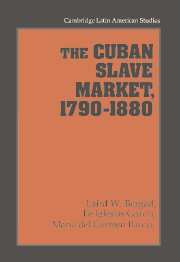Book contents
- Frontmatter
- Contents
- Tables and figures
- Preface and acknowledgments
- Glossary
- 1 Introduction: Prices and the historiography of slavery
- 2 Sources and methods of data collection
- 3 The development of African slavery and Cuban economic history
- 4 The price structure of the Cuban slave market, 1790–1880
- 5 Regional variations in the Cuban slave market: Havana, Santiago, and Cienfuegos
- 6 Coartación and letters of freedom
- 7 Conclusions and comparative perspectives
- Appendix A Nominal and real slave prices using international price indexes
- Appendix B Statistical data base on the Cuban slave market
- Bibliography
- Index
- CAMBRIDGE LATIN AMERICAN STUDIES
5 - Regional variations in the Cuban slave market: Havana, Santiago, and Cienfuegos
Published online by Cambridge University Press: 22 March 2010
- Frontmatter
- Contents
- Tables and figures
- Preface and acknowledgments
- Glossary
- 1 Introduction: Prices and the historiography of slavery
- 2 Sources and methods of data collection
- 3 The development of African slavery and Cuban economic history
- 4 The price structure of the Cuban slave market, 1790–1880
- 5 Regional variations in the Cuban slave market: Havana, Santiago, and Cienfuegos
- 6 Coartación and letters of freedom
- 7 Conclusions and comparative perspectives
- Appendix A Nominal and real slave prices using international price indexes
- Appendix B Statistical data base on the Cuban slave market
- Bibliography
- Index
- CAMBRIDGE LATIN AMERICAN STUDIES
Summary
The general characteristics of the Cuban slave market were summarized in the previous chapter by analyzing aggregated data on slave sales from Havana, Santiago, and Cienfuegos. This chapter will consider each area separately and offer comparative observations. Because the regional history of Cuban slavery was closely related to distinct patterns of socioeconomic development, brief local histories will provide frameworks for understanding the factors affecting the slave markets of each region.
Slavery and the socioeconomic development of the Havana region
Before the advent of large-scale plantation agriculture in the middle of the eighteenth century Havana and its environs experienced various economic transformations. The critical factor in the socioeconomic development of the colonial capital was its designation by the Crown in 1562 as the rendezvous point for the fleets from Vera Cruz and Panama before they returned to Spain laden with American treasure. The city's population was subsequently nurtured by colonial bureaucrats, officially sponsored colonists, and slaves imported to serve them. Its economy was strengthened by capital invested from Spain to fortify and protect the bay, as well as by the consumption demands of the fleet. Shipyards were built to service the fleet; docks and warehouses were constructed to facilitate commerce and storage; and truck farming and cattle ranches developed in rural areas close to the port to provision the city and its swollen population when the fleet arrived. These activities contributed to an impressive process of capital accumulation which would provide the foundation for the development of export agriculture in the eighteenth and nineteenth centuries.
- Type
- Chapter
- Information
- The Cuban Slave Market, 1790–1880 , pp. 79 - 121Publisher: Cambridge University PressPrint publication year: 1995

